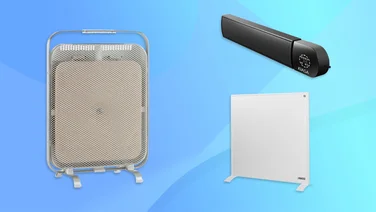To help us provide you with free impartial advice, we may earn a commission if you buy through links on our site. Learn more












- Cheap
- Easy to use
- Expandable
- Not the smartest thermostat
- Radiator valves add significantly to cost
With energy prices rocketing, and more consumers than ever looking at how best to save money on their bills, Hive’s new Thermostat Mini looks set to take full advantage.It’s the cheapest thermostat in British Gas’ range, undercutting the main Hive Smart Thermostat by £60 and it’s the most discreet as well, ditching the protruding buttons and knobs of its bigger brother in favour of a slimmed-down feature set and a move to all-touch controls.
Hive Thermostat Mini review: What do you get for the money?
The Hive Mini can be purchased on its own for a mere £59 but it’s only part of a larger system. The majority of users – those new to Hive – will need to buy the Hive Hub and Receiver units in addition to the thermostat itself in a package that costs £119.
On top of that, you’ll also need to pay for a professional installation (£100 if you want a Hive engineer to do it for you) as Hive does not recommend you install the system itself. The engineer will connect the Receiver unit to mains power and your boiler, hook up the Hub to your wireless router and install the thermostat in an appropriate location.
The thermostat itself is a neat device and a lot more discreet than the regular Hive Thermostat. It measures 85 x 22 x 85mm (WDH) (versus 90 x 37 x 90mm) and has a small colour screen hidden behind a mirrored front plate. The three touch-control buttons are arranged along the bottom of the front plate.












Just like the larger thermostat, the Hive Mini is mounted by clipping it onto a small plastic bracket that screws to your wall and is powered by four batteries (in this case AAA cells) so you don’t need to worry about running a mains cable through your walls to it.
Hive Thermostat Mini vs Hive Thermostat: What’s the difference?
Aside from the size, the key difference between the Hive Mini and its larger sibling is that the Mini offers less control at the thermostat itself.
It displays the current temperature when you tap the centre O button and allows you to adjust the target temperature up and down using the up and down buttons. It also lets you switch the heating on and off and put your heating into schedule mode, but that’s your lot.












With the larger Hive Thermostat you can create a schedule on the thermostat itself and tap a button on the top edge of the thermostat to put your heating into a temporary boost mode. With the Mini, you can still perform all these functions but you have to do so via the Hive app on your phone or your tablet.
READ NEXT: The best smart thermostats to buy today
Hive Thermostat Mini review: Hive app and Hive heating plus
It’s a bit of an irritation to lose the boost feature on the Hive Mini as that’s something I’ve become accustomed to over the years but, once I’d got used to firing up the app to do it instead, it quickly became second nature.
Of course, that’s not all that the app allows you to do. At its most basic, the app allows you to turn your heating on and off from wherever you happen to be, whether you’re at home or out and about.
It also lets you implement schedules, which can be as simple or as complicated as you like. You do this by setting up any number of slots, each of which is assigned a start time, end time and a target temperature.

Out of the box, each day is divided into four slots, with the heating coming on first thing in the morning and last thing at night and going into frost protection mode in between. However, you can have as many slots as you want, set to any number of different temperatures. To make setup easier, once you’ve set up one day’s schedule, you can copy that schedule to other days of the week or you can set up each day individually if you like. Simple.
You can leave it at that if you want, but the system only fully comes into its own if you enable its smart features, the most effective of which is its ability to support the optional Hive smart radiator valves.
These let you set up individual schedules and temperature targets for the rooms in which they’re installed. They replace your existing manual thermostatic radiator valves (TRVs), are powered by a couple of AA batteries and are simple to install yourself. They’re quite expensive at £54 each, though, and although you can save a bit by buying a multipack you can wind up paying quite a lot if you have a lot of radiators.

Other smart features include the ability to interface with Alexa, HomeKit and Google Home/Assistant and support for IFTTT, so you can set up more complex automations. There’s also “geolocation”, which will turn off the heating if it detects you’ve left the house and turn it on when you’re close to home.
Finally, there’s the Hive Heating Plus subscription service, an optional extra that adds features such as historical heating trends and central heating efficiency monitoring. The latter tracks how quickly your home reaches the target temperature and alerts you if that’s happening slower than usual.
The system will tell you how much you’re spending, provides tips on how to save money on your heating bills and will track any savings you make against a self-designated target figure – although that might be quite difficult in the current climate.












On top of that, Hive Heating Plus offers an extended warranty and 10% discount on other Hive products, such as the aforementioned radiator valves. All of which is well and good, but this seems a rather slim set of features for £3.99 a month (£40 a year).
The good news is that Hive is, slowly but surely, adding features to this list and, since this review was first published has introduced a new feature called Schedule Assist. This analyses your current schedule and makes suggestions on how to tweak things to make it more energy efficient. Based on the information you add when you set up the system, it shows you how much money the changes will save you and offers to make the change for you with a single button press.
The Hive system isn’t all about heating, though. There’s also a wide range of other smart hardware you can add to the app, from smart lightbulbs to door and motion sensors, and these can all be tied together by Hive “actions”.
These actions allow you to set up schedules for lights and trigger certain things based on motion or when doors open and close. There’s even a smart burglar alarm system you can integrate into the system.
Hive Thermostat Mini review: Performance
Overall, the Hive Mini performed as expected during testing and, other than the lack of a physical boost button, it worked exactly like its bigger sibling.
Its smaller size and more elegant lines are perfect for homes where the thermostat is out on show and it works brilliantly in conjunction with the Hive radiator valves, too, effectively creating a multi-zone heating system that ensures you’re never running the heating when it doesn’t need to.
As an example, I had one of the valves set up on my living room radiator with a schedule applied so that it only comes on in the evening, when I’m in there watching TV. Meanwhile, two radiators in upstairs bedrooms, which also have Hive valves on them, are set to come on early in the morning, so the house is warm when I wake up, and later at night so it’s nice and toasty as I go to bed.












I’m slightly less impressed with the level of smart features on the Hive Mini, however. Although you can add efficiency monitoring you have to pay extra for that, and the system doesn’t adapt itself automatically to your habits, the weather or your behaviour over time like the Nest thermostats do.
The only other thing I’d criticise the Hive Mini over is the way the smart radiator valves work is a little counterintuitive and, therefore, somewhat confusing. Instead of simply turning the heating on when your schedule kicks in for each valve and turning off when the target temperature is reached, they put the heating system into Boost mode for 30 minutes until the target temperature is reached and, if it doesn’t reach the target in this time, it sets another boost period in motion.
To be completely fair, this achieves largely the same thing and the app does explain what it’s doing, but it does seem an unnecessarily complicated way to go about the process.
READ NEXT: The best smart thermostats to buy today
Hive Thermostat Mini review: Verdict
Aside from those niggles, however, the Hive Mini is an effective smart thermostat and one that I’ve found works effectively.
It’s great that the system can be expanded to provide multiroom control using Hive’s smart radiator valves and it’s also very easy to add other smart devices to the app’s front end and set up automations.
Products from Tado, Google Nest and Honeywell are smarter and offer more features out of the box but, at this price, the Hive Mini is among the cheapest smart thermostats around and represents an affordable way to get into the world of smart thermostats.


















